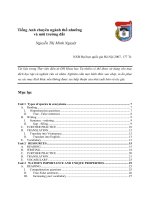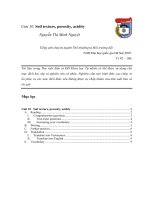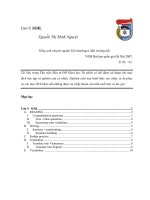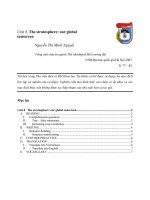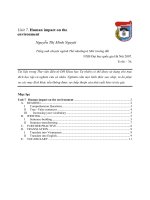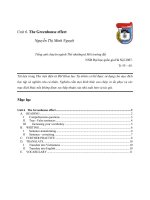Tiếng anh chuyên ngành Thổ nhưỡng và Môi trường đất phần 12 potx
Bạn đang xem bản rút gọn của tài liệu. Xem và tải ngay bản đầy đủ của tài liệu tại đây (219.26 KB, 11 trang )
Tiếng anh chuyên ngành Thổ nhưỡngvà Môi trường đất
NXB Đại học quốc gia Hà Nội 2007.
Tr 110 – 119.
Tài liệu trong Thư viện điện tử ĐH Khoa học Tự nhiên có thể được sử dụng cho mục
đích học tập và nghiên cứu cá nhân. Nghiêm cấm mọi hình thức sao chép, in ấn phục
vụ các mục đích khác nếu không được sự chấp thuận của nhà xuất bản và tác giả.
Mục lục
Unit 12 PROFILES OF SOILS 2
A. READING 2
B. WRITING 3
C. Further practice 7
D. Translation 8
I. Translate into Vietnamese 8
II. Translate into English 8
E. VOCABULARY 9
Unit 12. PROFILES OF SOILS
Nguyễn Thị Minh Nguyệt
Unit 12
PROFILES OF SOILS
A. READING
• Warm-up Activities
- What do you examine when you want to compare two soils?
- What do soil profiles represent?
Profile of soil A: Red Earth
The A-horizon extends to a depth of 36 cm. The soil consists of a brownish red sandy
loam. It has a porous and friable granular structure which is mixed with pebbles. The B-
horizon extends from 36 cm to 130 cm and is red in color. It is a sandy loam, gravelly in
structure with large quantities of pebbles. The C-horizon, which extends down to 244 cm, has
a yellowish white color. It is sandy, with a structure which is a cemented and compact mass,
made up of decomposed felspars.
(Taken from "English in Agriculture" by Alan Mountford)
Now study the following figure which summarizes the information presented in the
description above.
Horizon Depth (cm) Color Soil type
(textural class)
Structure Other features
A 0 – 36 brownish
red
sandy loam porous and
friable
granular
mixed with
pebbles
B 36 - 130 Red sandy loam gravelly mixed with large
quantities of
pebbles
C 130 - 244 yellowish
white
sandy cemented
and
compact
mass
decomposed
felspars
Figure 2: Profile of Soil A: Red Earth
B. WRITING
Exercise 1: Writing descriptions from figures.
Read the following descriptions of soil profiles and made figure presenting the
information as in the example above:
Profile of soil B: Laterite
The A-horizon extends down to 61 cm. Its color is brownish deep red. The textural class
of the soil is a clay loam. It has a loose granular structure which is mixed with gravel. The B-
horizon which extends from 61 cm to 259 cm is a clay loam. It is bright red with a gravelly
laterite structure. The C-horizon below 259 cm is red, mottled with yellow and whitish colors.
It is rocky consisting of honey-combed laterite.
Horizon Depth (cm) Color Soil types
(textural class)
Structure Other features
A
B
C
Figure 3: Profile of soil B: Laterite
Profile of soil C: Mountain and hill soil
The A-horizon extends to a depth of 18 cm. Light brownish gray in color; the soil type is
a sandy loam with a friable granular structure. Another feature is that it is slightly sticky when
wet. The B-horizon extends from 18 cm to 66 cm. It is yellowish brown in color and consists
of a moist clay loam having a blocky, very hard and compact structure. It is also sticky when
wet. The C1-horizon goes down to 97 cm and is yellowish brown in color. A moist clay loam,
the soil has a blocky, extremely firm structure which is difficult to cut. It is very sticky when
wet, and some parent material is mixed with the soil. Below 97 cm, the C2-horizon is
yellowish brown, a clay loam which is soft and easy to cut when moist. It has a laminated and
compact clay shale structure.
Horizon Depth (cm) Color Soil type (textual
class)
Structure Other feature
A
B
C
1
C
2
Figure 4: Profile of soil C: Mountain and hill soil
Exercise 2. Write descriptive paragraphs:
Study the following figure and then complete the paragraph below describing soil
profile D.
Horizon Depth (cm) Color Soil type
(textural class)
Structure Other features
A
1
0 - 15 brownish
gray
coarse sandy
clay loam
crumb contains pieces
of quartz
A
2
15 - 61 dark gray heavy clay loam hard crumb
B 61 - 137 brownish
or whitish
gray
heavy clay loam hard crumb contains white
and dark
carbonate
nodules
C below 137 ash gray heavy clay loam mixed with
disintegrating
rock
Figure 5: Profile of soil D: Black soil
extends to a depth of . in color, the soil type is
with a structure. A feature is the presence of
. extends from and is in color. It consists of
a having a . The B-horizon goes down to
and is in color. The textural class of the soil is a
The soil has a which contains .
Below 137 cm the C is ,
a
Exercise 3: Write descriptive paragraphs of your own bases on the figures below.
Horizon Depth (cm) Color Soil type
(textural class)
Structure Other feature
A 0 - 18 pink silty loam blocky, tending
to be weakly
granular
dry and hard
B 18 - 58 light
brown
silty clay loam weakly laminar,
developing to
blocky and nutty
somewhat
porous and dry
C 58 - 127 pinkish
to slight
brown
silty clay loam compact and
hard
somewhat
gritty
Figure 6: Profile of soil E: Desert soil
Exercise 3. Comparative sentences.
We can make comparative statements using the following patterns:
Particles of fine sand are coarser than particles of clay.
= Particles of clay are not as coarse as particles of fine sand.
Transported soils are more common than sedentary soils in humid regions.
= Sedentary soils are less common than transported soils in humid regions.
Soil particles Diameter (mm)
gravel 2.0 or more
coarse sand 2.0 - 0.2
fine sand 0.2 - 0.02
silt 0.02 - 0.002
clay 0.002 or less
Figure 7: Soil particles
Compare the particle size of:
1. fine sand with silt (fine)
2. clay with fine sand (coarse)
3. fine sand with gravel (coarse)
A: light sandy soil B: heavy clay soil
% %
gravel 1.2 1.3
sand 37.4 33.7
silt 38.6 26.9
clay 11.8 28.3
humus 4.5 7.8
other contents 6.5 2.0
Figure 8: Soil contents
Compare the contents of these soils in terms of:
(i) The percentage of
(ii) The content
(iii) A light sandy soil
1. their sand content
2. their silt content
3. their clay content
4. their humus content.
Top soil Sub-soil
Color dark light
Particle sizes coarse fine
Living organisms many few
Elements for plant food rich poor
Figure 9: Characteristics of the top soil and the sub-soil
Using the information in figure 9 compare the characteristics of the top soil and the
sub-soil in terms of:
1. color:
(i) The top soil
(ii) The sub-soil is
2. particle size:
(i) The particle sizes of the top soil
(ii) The particle sizes of the sub-soil
living organisms:
(i) There are in the top soil.
(ii) There are in the sub-soil.
3. elements for plant food:
(i) The top soil is
(ii) The sub-soil is
C. Further practice
Making comparison by inference Complete the sentences with the comparative from of
an appropriate adjective, or more / less.
1. Soils show great variations in their sizes and arrangements of their constituent particles.
A sandy soil has larger particles than a clay soil. A sandy loam has
particles than a clay loam.
2. Soils also vary greatly in color. A brightly colored soil indicates a higher degree of
oxidation. So, a red soil has been oxidized than a black soil.
3. As agriculture becomes more intensive, the soil may be modified by those who form it.
A soil can be made less alkaline by adding sulphur. Any soil can be made
acid by adding lime.
4. The sulphur content of certain soils in Oregon, U.S.A., is less than 0.15%. On average in
the U.S.A. soil contains several times this amount. We may say then that most soils
contain sulphur than those of Oregon.
5. All the spaces, or pores, in between the solid soil particles are filled with air and water.
The proportions of air and water which are contained in these pores are determined
mainly by the size of the pores. The bigger the size of the pores the more air and
water the soil will contain. Thus, sandy soils contain larger pore
spaces, but the total amount of pore space is because the particles
are . On the other hand, clay soils contain smaller pore spaces but the
total amount of pore space is because the particles are
much . As a result, clay soils are generally than sandy
soils.
D. Translation
I. Translate into Vietnamese
The idea of sustainable development was first presented by the International Union for the
Conservation of Nature (IUCN 1980) in an international forum of the World Conservation
Strategy. In essence, the concept of sustainable development invokes present development of
available resources without compromissing the ability of future generations to meet their
needs. Many people would argue that this is an abstract idea that is impossible to achieve.
How can this generation understand the needs of future generations, even before they have
been born, let alone future needs before they have been formulated.
The practical application of the concept of sustainable development should involve a
greater environmental awareness, by both governments and individuals. The IUCN argued
that three priorities should be incorporated into all development programmes:
♦ the maintenance of ecological processes
♦ the sustainable use of resources
♦ the maintenance of generic diversity.
(Taken from "UNEP World Wide Web Site 1996")
II. Translate into English
1. Các hoạt động của thực vật và động vật sống và sự phân hủy của các chất thải hữu cơ
và các chất cặn bã có ảnh hưởng đến sự phát triển của đất. Sự khác nhau của các loại đất
mà ban đầu là do sự khác nhau của cây trồng là điều đáng chú ý đặc biệt trong việc thoát
hơi nước ở lá cây. Minnesota, Illinois, Missouri, Oklahoma, Taxas và phần lớn các bang
ở phía tây nước Mỹ là những nơi mà người ta có thể dễ dàng quan sát được sự khác biệt
này.
2. Khí hậu cũng có ảnh hưởng đến sự hình thành của đất một cách gián tiếp thông qua các
tác động của nó đối với cây trồng. Các loại khí hậu khô chỉ cung cấp đủ độ ẩm cho các
loại cỏ ngắ
n và thưa hoặc cây bụi. Chúng không đủ dày đặc để bảo vệ đất khỏi sự xói
mòn do gió và xói mòn do nước gây ra.
3. Các loại đất thay đổi theo số lượng các chất dinh dưỡng (khác nhau) mà chúng có thể
cung cấp cho sự phát triển của cây trồng. Hàm lượng các chất dinh dưỡng có sẵn phụ
thuộc vào:
♦ nhu cầu và khả năng cạnh tranh chất dinh dưỡng của cây cối
♦ số lượng và các nguồn cung cấp chất dinh dưỡng hiện hữu
♦ các điều kiện môi trường như nhiệt độ, nước, tính thấm khí
Để biết được nhu cầu về phân bón cho từng loại đất này chúng ta cần phải xem xét
cả ba yếu tố trên.
E. VOCABULARY
1. arrangement (n) : sự sắp xếp
2. coarse (adj) : thô, không mịn
3. coarse sand (n) : cát thô
4. evaporation (n) : sự bốc hơi, sự bay bơi (về mặt vật lý)
5. evaportranspiration : sự thoát hơi nước (qua lỗ khí trên bề mặt lá)
6. extend (v) : mở rộng
7. fine sand (n) : cát mịn
8. felspar (n) : khoáng fenspat
9. friable (adj) : dễ nát vụn
10. future generation (n) : thế hệ tương lai
11. granular (adj) : như hột, có dạng hột
12. gravelly (adj) : như sỏi
13. honey-comb (n) : hình tổ ong
14. humus (n) : mùn
15. shrink (v) : co lại, rút ngắn lại
16. laminate (v) : cán mỏng
17. laterite (n) : đá ong, đá đỏ
18. modify (v) : làm thay đổi
19. moist (adj) : ẩm
20. mottle (v) : chấm, lốm đốm
21. pebble (n) : đá cuội, sỏi
22. sedentary soil (n) : đất tàn tích
23. shale (n) : phiến thạch
24. silt (n) : bùn
25. silty soil (n) : đất bùn
26. summarize (v) : tóm tắt
27. sustainable development (n) : sự phát triển bền vững
28. transported soil (n) : đất hình thành trên bồi tích
29. vary (v) : thay đổi
30. IUCN
(International Union for the Conservation
of Nature)
: Tổ chức Quốc tế về bảo tồn thiên nhiên


